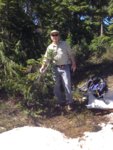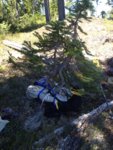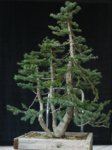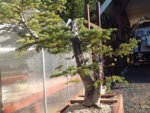River's Edge
Masterpiece
This tree was previously posted on collection and recently as it showed signs of recovery. This thread will be to document the development process as it proceeds over the years. In summary, collected spring of 2017, placed in grow box with pure pumice. basically a very gentle bare root with chopstick and water flushing to remove native soil, rocks, dead roots etc.
Today was moving day, used the rings in the box to attach rope and lift onto two wheel dolly. Then used the dolly to stabilise and tip the grow box and tree onto the edge of the hydraulic cart. Then the ropes to slide the rest of the way onto the hydraulic cart and rolled into the workshop. This is my first opportunity to look at all aspects of the tree since collection. The only work since repotting was to remove dead foliage, unwanted branches, administer preventative treatments for fungal and insect issues that could be expected with collected fir.
The basics are as follows: Main trunk has a 4 1/2 inch base and is 48 inches tall, secondary trunk is 36 inches tall with a 2 1/2 inch base, third trunk is 30 inches tall and has a 1 1/2 inch base. The trunks are closely connected and the combined base spread is approximately 8 inches.
I have included six pictures to show the four sides and dimensions. I believe the front is fairly easy to determine. I like the view with the larger tree to the right front, the secondary tree is slightly behind and to the left of the main one. The third trunk is a bit further to the front and left of the secondary trunk but still behind the main trunk. I have used that view to include the tape measure for dimensions. I will post progress as decisions and work proceeds.





Today was moving day, used the rings in the box to attach rope and lift onto two wheel dolly. Then used the dolly to stabilise and tip the grow box and tree onto the edge of the hydraulic cart. Then the ropes to slide the rest of the way onto the hydraulic cart and rolled into the workshop. This is my first opportunity to look at all aspects of the tree since collection. The only work since repotting was to remove dead foliage, unwanted branches, administer preventative treatments for fungal and insect issues that could be expected with collected fir.
The basics are as follows: Main trunk has a 4 1/2 inch base and is 48 inches tall, secondary trunk is 36 inches tall with a 2 1/2 inch base, third trunk is 30 inches tall and has a 1 1/2 inch base. The trunks are closely connected and the combined base spread is approximately 8 inches.
I have included six pictures to show the four sides and dimensions. I believe the front is fairly easy to determine. I like the view with the larger tree to the right front, the secondary tree is slightly behind and to the left of the main one. The third trunk is a bit further to the front and left of the secondary trunk but still behind the main trunk. I have used that view to include the tape measure for dimensions. I will post progress as decisions and work proceeds.










